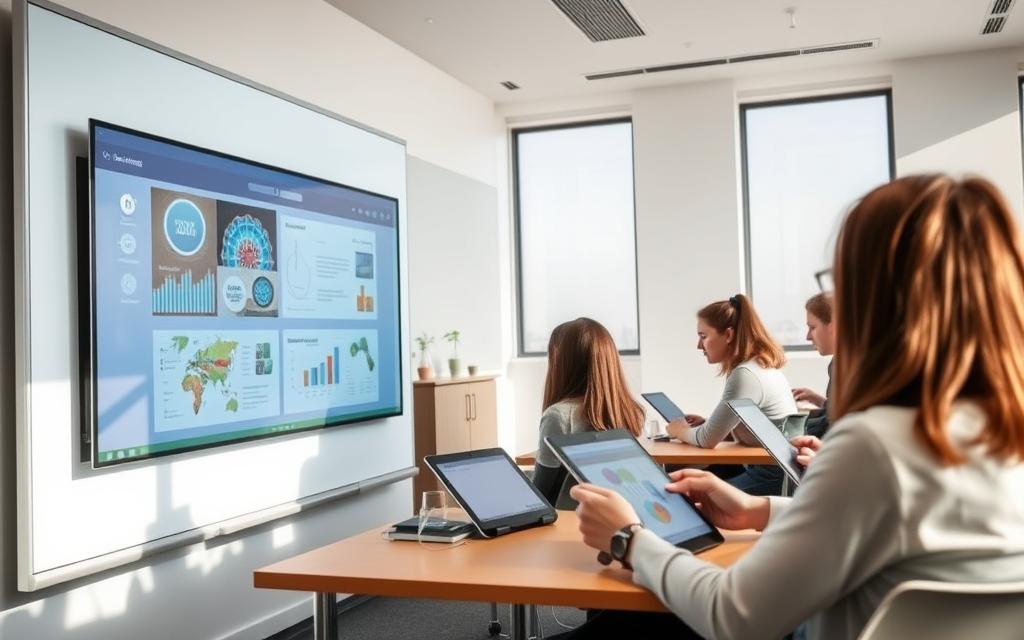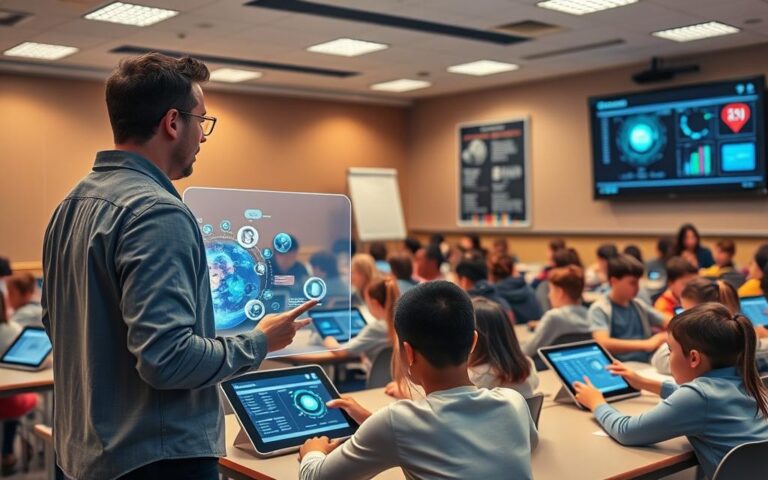Did you know adults spend about 11 hours a day on screens? This fact shows the difficulty educators and trainers face getting attention today. Traditional training methods are changing. They’re making room for new ways that grab learners’ interest and really work.
Microlearning is leading the change in corporate training. It offers short learning moments that help people remember more easily and fit different ways of learning. Looking ahead, it’s crucial for corporate training plans to include microlearning. It’s not just helpful–it’s necessary.
What is Microlearning?
Microlearning is a new way of teaching that’s gaining popularity. It gives lessons in short, focused bursts. This helps people remember information better and fits with how many prefer to learn today.
Definition and Key Characteristics
Microlearning offers lessons that are small and to the point, usually lasting from 7 to 15 minutes. These short lessons help students learn without feeling too stressed. The main features of microlearning are:
- Focused Content: Each lesson focuses on a single topic or skill.
- Easy Accessibility: Students can learn on different devices, which makes it easy to learn anywhere.
- Engagement: It often includes interactive parts to keep students interested and motivated.
The Evolution of Learning Methods
Learning methods have changed a lot, moving towards easier-to-digest formats. Old-school teaching often involved long lectures that could overwhelm students. Microlearning, on the other hand, offers a better way. It lets students understand and remember things more easily. By using techniques like spaced repetition, it works really well with how our brains learn.
| Traditional Learning Methods | Microlearning |
|---|---|
| Long, exhaustive sessions | Short, focused segments |
| Potential for cognitive overload | Reduces cognitive burden |
| Less engagement | Higher learner engagement |
| One-size-fits-all approach | Tailored learning experiences |
The move to microlearning shows a big change in what today’s learners want. This change is making professional training much better.
The Benefits of Microlearning in Training
Microlearning offers a lot of benefits that make training in the workplace better. It uses short, focused learning segments to help organizations. These help people remember information better, increase engagement, and make training materials accessible anytime.
Enhanced Retention of Information
Microlearning makes it easier for learners to remember things. Instead of long sessions, information is delivered in short bursts. This way, employees can better understand and recall what they learn.
They can go back and review the content whenever they need. This helps them use what they’ve learned in real-life situations effectively.
Increased Engagement among Learners
Microlearning keeps learners interested. Traditional training can be dull, but microlearning uses interactive and quick modules. This fits what today’s workers want.
With engaging and varied learning experiences, employees are more likely to take part and stay motivated.
Flexibility and Accessibility
Being flexible and easy to access are big pluses of microlearning. It allows employees to learn whenever and wherever they are.
This is perfect for modern workplaces where people have lots to do. Microlearning means training works well and is convenient for everyone.
How Microlearning Fits into Modern Workplaces
In modern workplaces, microlearning is a key tool. It lets employees balance their time well. It also fits their personal ways of learning.
Adapting to Busy Schedules
Today’s workers have packed schedules. Microlearning fits right in. They can learn through mobile platforms anytime, anywhere. This way, they can learn in short moments. Like during a break or on the way to work. They can easily fit learning into their day.
Catering to Diverse Learning Styles
Microlearning works for all types of learners. It offers various learning methods. This includes visual, auditory, and hands-on styles. Videos, infographics, and interactive activities help everyone learn their way.
| Learning Style | Microlearning Format | Example |
|---|---|---|
| Visual | Videos and Infographics | Animated tutorials on new software features |
| Auditory | Podcasts and Audiobooks | Interview series with industry experts |
| Kinesthetic | Interactive Simulations | Hands-on practice with a virtual tool |
Microlearning’s flexibility boosts learning at work. It lets employees learn in their own way. This new method helps make a happier, more effective team.
Microlearning Tools and Technologies
The effectiveness of microlearning is closely tied to the tools and technologies used. Choosing the best platform can greatly impact how well engaging content is delivered. It also helps in creating a continuous learning culture. Important training tools have a big role in this.
Popular Platforms for Microlearning
Some platforms really shine in the world of microlearning. Google Primer offers quick lessons that are easy to use on smartphones. This makes learning not just convenient, but also fun. On the other hand, The Training Arcade uses small games to help remember things better. This makes learning feel more like playing.
| Platform | Key Features | Benefits |
|---|---|---|
| Google Primer | Interactive lessons, Mobile-friendly | Convenient learning, High engagement |
| The Training Arcade | Gamified learning experiences, Microgames | Increased motivation, Improved retention |
Gamification in Microlearning
Adding game-like features to microlearning makes it more enjoyable. Using things like points, badges, and challenges motivates people. It encourages them to dive into the material. This fun way of learning not only boosts participation. It also helps understand the content much better.
Designing Effective Microlearning Modules
Creating captivating and educational microlearning modules demands careful planning. It’s all about focusing on clear and relevant content. This helps learners reach their goals quickly.
Content must be short and to the point, focusing on specific outcomes. Using multimedia in training is key for engagement.
Best Practices for Content Creation
To create effective microlearning content, you need a good plan. Here are the top tips:
- Focus on a single concept: Teaching one thing at a time helps people remember and understand better.
- Keep it brief: Modules should last only 3 to 5 minutes.
- Set clear learning objectives: Make it clear what learners will gain after the module.
- Use relatable scenarios: Using situations people can relate to makes the learning stick.
Incorporating Multimedia Elements
Adding multimedia to microlearning is key for engagement. Things like videos, animations, and infographics make learning better. Studies show visuals beat text-only every time. People remember more when the format catches their interest. Good multimedia options include:
- Video clips: Brief videos that explain ideas clearly and add excitement to the learning process.
- Interactive quizzes: Quizzes help reinforce what’s been learned and let learners test their knowledge.
- Infographics: These make complicated ideas easier to grasp and remember.
| Multimedia Element | Benefits |
|---|---|
| Video Clips | Shows concepts visually for better understanding. |
| Interactive Quizzes | Boosts engagement and helps with remembering facts. |
| Infographics | Makes hard topics easier to understand. |

Real-World Applications of Microlearning
Microlearning has become key in many fields, changing how we train people. Organizations are now using it to close skill gaps and create better learning spaces. This section shines a light on its big impact across various sectors.
Case Studies from Various Industries
Many industries have taken up microlearning to improve their training. In healthcare, this means new tools that keep medical staff current. Tech companies teach new software through brief, focused lessons. This helps employees catch on faster. In manufacturing, microlearning on safety practices has made workplaces safer. These cases show how microlearning meets specific training needs well.
Success Stories and Testimonials
Companies using microlearning see real benefits in how their employees perform. One big pharmaceutical company noticed fewer safety issues after adopting microlearning. This method didn’t just help people remember better; it also sparked ongoing improvement. Another business saw its team’s engagement levels soar, thanks to microlearning’s easy-to-digest approach. These successes make it clear: microlearning really works in the business world.
Measuring the Impact of Microlearning
To find out if microlearning works, organizations must effectively measure its impact. This involves using different Key Performance Indicators (KPIs) in training. Knowing which KPIs to watch helps understand how well the training is doing. Picking the right indicators and getting structured feedback lets businesses keep improving their learning methods.
Key Performance Indicators (KPIs) to Consider
Choosing the correct KPIs is key to understanding the impact. Here are important KPIs in training that offer useful insights:
| KPI | Description | Importance |
|---|---|---|
| Engagement Rate | Percentage of learners actively participating in the training. | Helps determine the appeal of the content and learner motivation. |
| Knowledge Retention | Measure of how much information learners retain after training. | Indicates the effectiveness of the training in delivering lasting knowledge. |
| Completion Rate | Number of learners who finish the training program. | Shows how compelling the training is and identifies potential drop-off points. |
Feedback Mechanisms for Continuous Improvement
Using feedback to improve microlearning is crucial. Organizations should use different ways to get feedback:
- Surveys: Gathering opinions from learners about the content’s quality and how easy it is to use.
- Assessments: Checking what learners know before and after the training to measure its effect.
- Focus Groups: Getting detailed feedback from a small group of learners.
These methods help organizations keep improving their microlearning. They make sure it meets the needs of employees and the company.
Challenges in Implementing Microlearning
Switching to microlearning can be a big change for organizations. There are several hurdles in training that may pop up. A common barrier is resistance to change, as some employees may not want to leave behind traditional training methods. Another challenge is making sure the content is good and consistent across all platforms. This can be tough for teams trying to make learning fun and engaging.
Common Barriers Organizations Face
- Resistance to Change: Employees might feel unsure about new strategies and prefer what they know.
- Content Quality Control: Keeping material top-notch on various platforms can be tough.
- Lack of Leadership Support: Without support from leaders, microlearning efforts may not take off.
- Limited Resources: Some organizations might not have what they need to start microlearning programs.
Strategies to Overcome Challenges
To get past these obstacles, organizations can take several steps. It’s important to make an action plan.
- Foster a Culture of Innovation: Create a safe space for employees to try new learning methods.
- Secure Leadership Buy-in: Leaders should get behind microlearning to encourage everyone to come on board.
- Invest in Professional Development: Offer training for teams so they can make and share top-quality content.
- Utilize Feedback: Always ask for employee feedback to see what can be better and fix it.
Future Trends in Microlearning
Microlearning is changing fast, thanks to tech and artificial intelligence in training. These advances promise better learning journeys, tailored just for you. Your learning will be more personal, meeting your exact needs.
The Role of Artificial Intelligence
Artificial intelligence in training is a game-changer. It’s changing how companies teach skills and knowledge. AI can look at how you learn and what you do. Then, it makes your training fit you better. This means lessons are shaped by your own way of learning.
Predictions for the Next Five Years
In the next five years, AI and tech like virtual reality will mix more with microlearning. These advances will make learning not just fun but really effective. You’ll get to practice skills as if you were in the real world. This mix will make learning stick better and make training top-notch.
Conclusion: Embracing the Microlearning Revolution
Organizations are moving towards more efficient training methods, making microlearning essential. This method boosts learning and fits the modern workforce’s needs. It adapts to busy schedules, helping employees develop skills continuously.
For this change, companies should review their training programs. Finding gaps and opportunities helps tailor microlearning for their teams. They should explore different tools and techniques to make microlearning effective.
Adopting microlearning is not just an option, but a strategic decision for growth. It prepares companies for the future by promoting a learning culture. This way, they stay ahead in changing times. Taking steps now means being ready for tomorrow’s training challenges.




